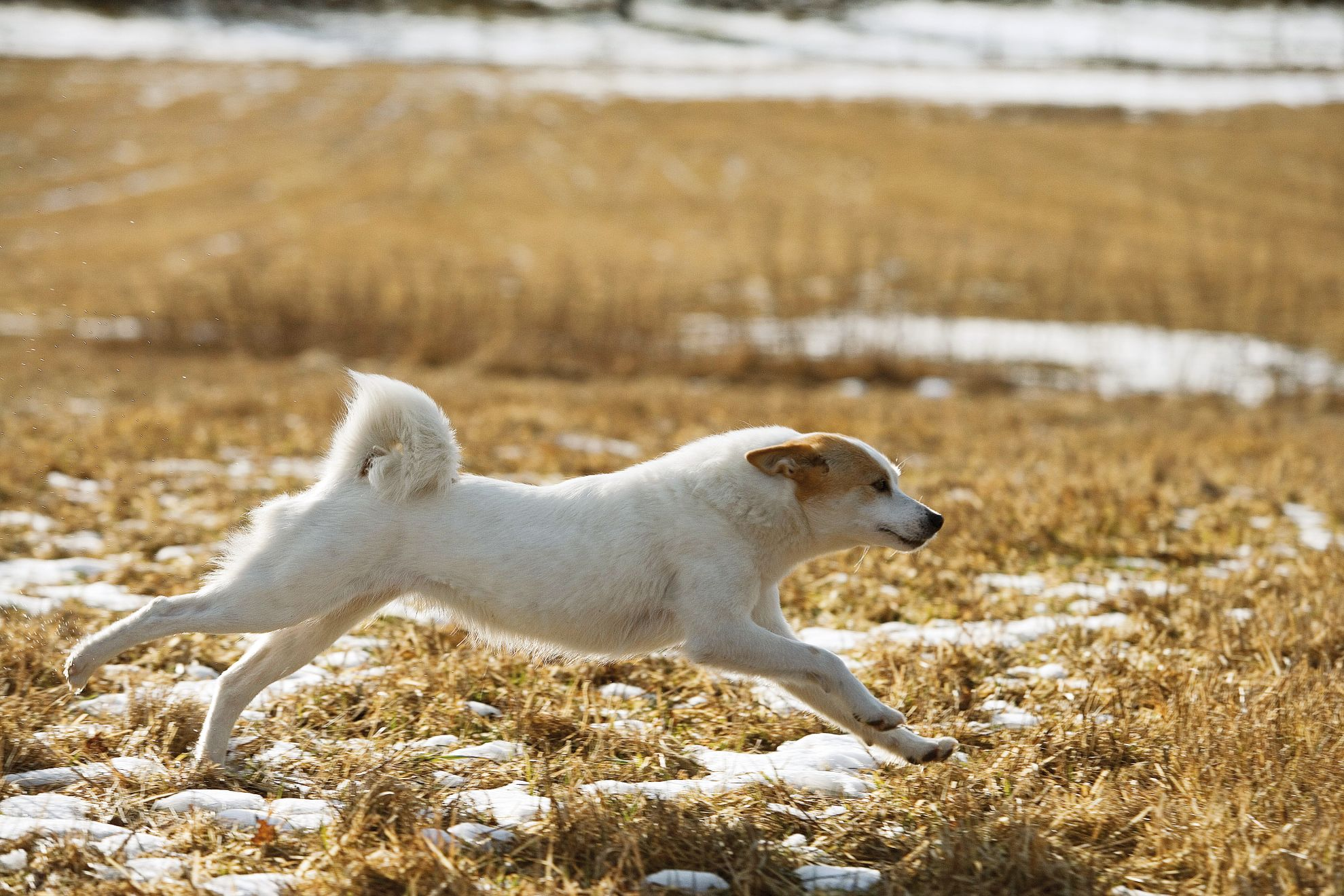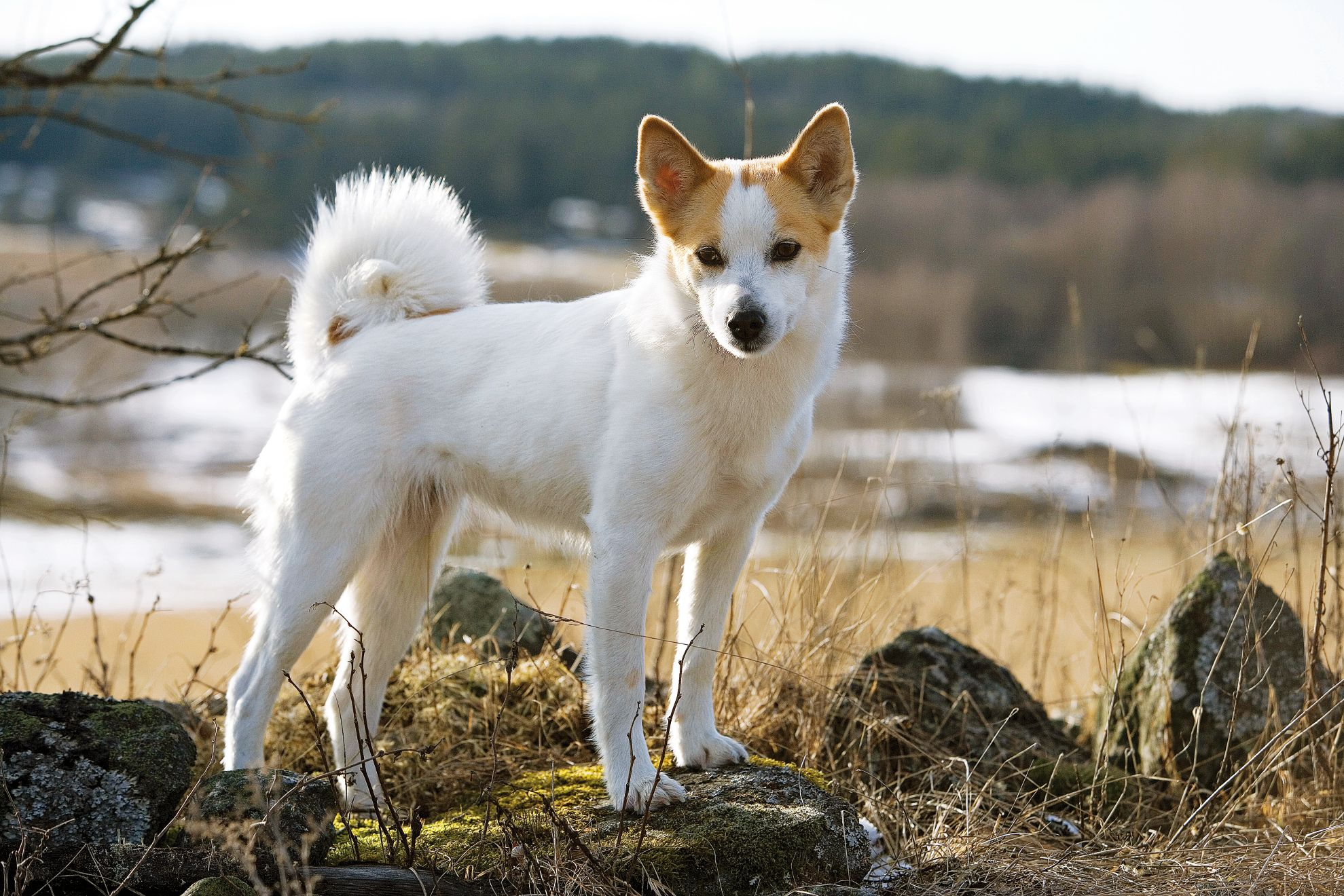
Let's talk Norrbottenspitzes
Sweden’s native Norrbottenspitz is graced with distinctive markings that make them easy to spot: delicate fawn-coloured patches fall over their eyes and elsewhere. A weatherproof coat has helped them survive harsh Scandinavian climes for centuries. A spitz-type dog, the Norrbottenspitz’ smaller size is a welcome trait for dog owners, and their affable yet gutsy approach makes them a good choice for active owners. This is a confident dog, attentive to home life and everybody in it, including other animals once they are properly introduced. Although almost extinct at one point, the breed has made a splash in new places around the world, rugged or otherwise.Official name: Norrbottenspitz
Other names: Norrbottenspets, Nordic Spitz
Origins: Sweden

| Drooling tendencies: |
|
Warm weather? | |
| Shedding level: | Suited to apartment living? | ||
| Physical activity needs (high, low, medium): | Low | Kid-friendly? |
|
| Compatibility with other pets: | Can stay alone? |
We advise against leaving pets alone for long stretches.
Companionship can prevent emotional distress and destructive behaviour.
Speak to your veterinarian for recommendations.


| Baby age | Birth to 2 months |
| Puppy age | 2 to 12 months |
| Adult age | 1 to 7 years |
| Mature age | 7 to 10 years |
| Senior age | 10 years onwards |

1/7
Get to know the Norrbottenspitz
All you need to know about the breed
An amiable and docile breed, the Norrbottenspitz delights owners and onlookers alike with their curly tail, perky ears, and almost jovial-like expression. Being bred in the far northern reaches of Europe - Norrbotten, Sweden and in Finland - has resulted in this dog’s agile body as well as intrepid character: The Norrbottenspitz was originally raised to be a farm and hunting dog, and when used for the latter, was especially good at holding large game at bay. This is a determined breed, for sure.
Today’s Norrbottenspitz is still used as a sporting dog but can also make for a superb security dog on the homefront, such are the instinctive traits they have when it comes to protecting the family. They are good with other household pets and around children, once trained of course, and are recommended for first-time dog owners because of their all-around agreeable demeanour.
Those pointed ears and that curly tail are surefire spitz breed characteristics, too, along with the pointed muzzle and thick bushy coat. These types of dogs typically hail from northern regions of the world and almost always have a very energetic, buoyant outlook. That does mean a good deal of barking but early training of your Norrbottenspitz can help keep it to a minimum.

2/7
2 facts about Norrbottenspitzes
1. Making their voice heard
Originally bred to hunt, the Norrbottenspitz was raised to use their voice in the field in a series of high-pitched, rapid barks alerting owners to their location. Giving voice might be great on the job, but on the homefront, your Norrbottenspitz will need to be trained to keep it down and keep the wrath of neighbours down in the process.
2. Total recall
As a dog that’s used to accompanying sportsmen, the Norrbottenspitz will also need to get used to recall. They were originally bred to chase, a drive that’s not so easily dispelled. Keep them on leash when out on walks to keep them from following fellow furry friends that they shouldn’t.
History of the breed
The Norrbottenspitz breed is said to go back thousands of years living in the icy regions of northern Europe, specifically Sweden and Finland. Hunting was the way to survive, and the Norrbottenspitz was intrinsic to carrying out these daily duties.
The breed maintained their treasured position in the two countries for centuries, and the first breed standard was written for them in 1910 by the Swedish Kennel Club. Like many dogs, they suffered greatly during World War II, due to conflict but also due to loss of interest in the breed - so much so that the Swedish Kennel Club declared them extinct in 1948.
Despite those hardships, the Norrbottenspitz survived in some of the most remote villages in both Sweden and Finland and continues to thrive due to a large number of enthusiasts. The Norrbottenspitz was registered by the American Kennel Club in 2007 with 236 official registrations recorded to date.

4/7
From head to tail
Physical characteristics of Norrbottenspitzes
1. Ears
Ears set high, very erect and pointed, just over medium-sized.
2. Body
Level body, hard musculature, compactly built.
3. Coat
Hard, short and straight topcoat lying close to body, dense undercoat.

5/7
Things to look out for
From specific breed traits to a general health overview, here are some interesting facts about your Norrbottenspitz

6/7
Caring for your Norrbottenspitz
Grooming, training and exercise tips
The Norrbottenspitz possesses a double coat, with a hard, short, straight topcoat and a fine, dense undercoat. A weekly brushing should do the trick as well as the occasional bath to keep them clean. And don’t miss their characteristic curled tail, which will need attention, too. Brush your dog’s teeth often and clean eyes, ears, and paw pads of debris, and trim their nails as needed. Owners will be pleasantly surprised to find that the Norrbottenspitz doesn’t suffer from much canine odour. This is a breed who was originally bred to run and chase, so the Norrbottenspitz will need an active owner who will enjoy the exercise routine as well. Norrbottenspitz are extremely agile so have excelled over the years in many types of canine competitions. Calm and kindness are hallmark characteristics of the Norrbottenspitz breed so training them should be easy. They are known to be obedient and compliant and will take to direction very well.7/7
All about Norrbottenspitzes
The American Kennel Club first classified the Norrbottenspitz in the Foundation Stock Service in November 2007, then placing them in the Miscellaneous Group in 2014. When fully recognised, the Norrbottenspitz breed will be considered a hound, given their acumen and long history in the field.
The current count of the Norrbottenspitz breed worldwide hovers in the low thousands, with only 236 of the dogs with three generations officially registered with the American Kennel Club to date.
translations.feature.breeds.otherbreeds
Read more on this topic

How your dog's nutrition needs change with age

How to adopt a dog

Things to consider before getting a dog
Sources
1 - Veterinary Centers of America https://vcahospitals.com/
2 - Royal Canin Dog Encyclopaedia. Ed 2010 and 2020
3 - Banfield Pet Hospital https://www.banfield.com/
4 - Royal Canin BHN Product Book
5 - American Kennel Club https://www.akc.org/



